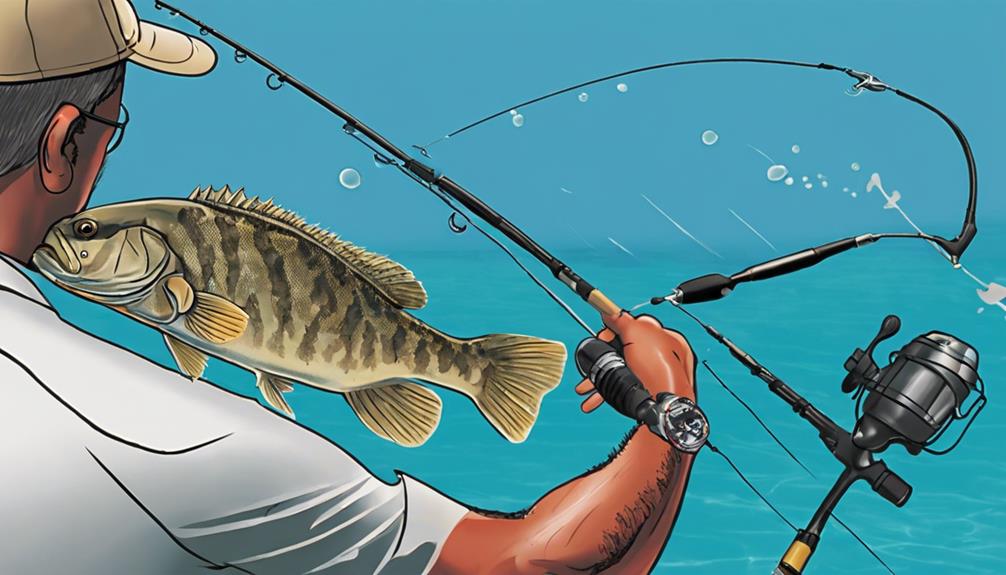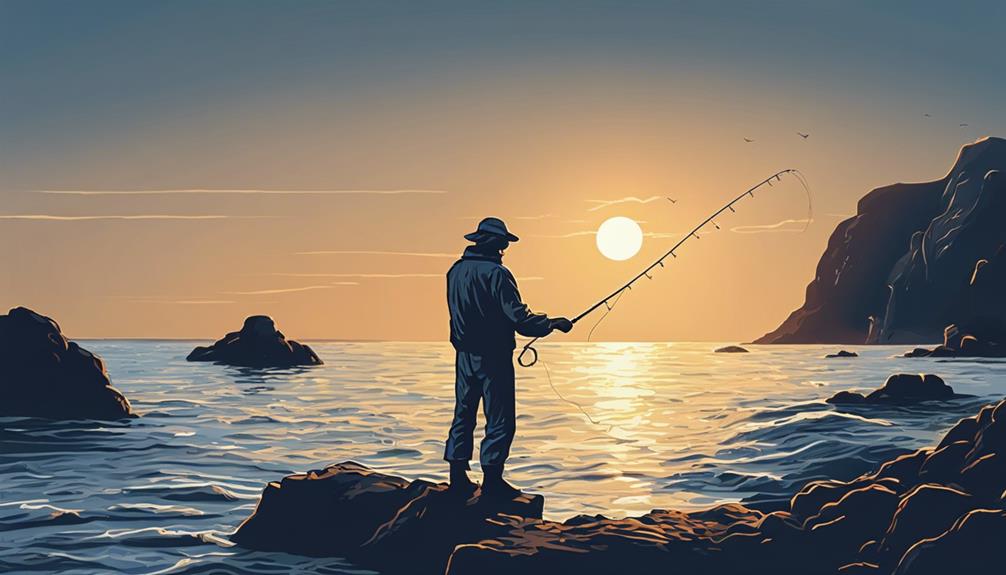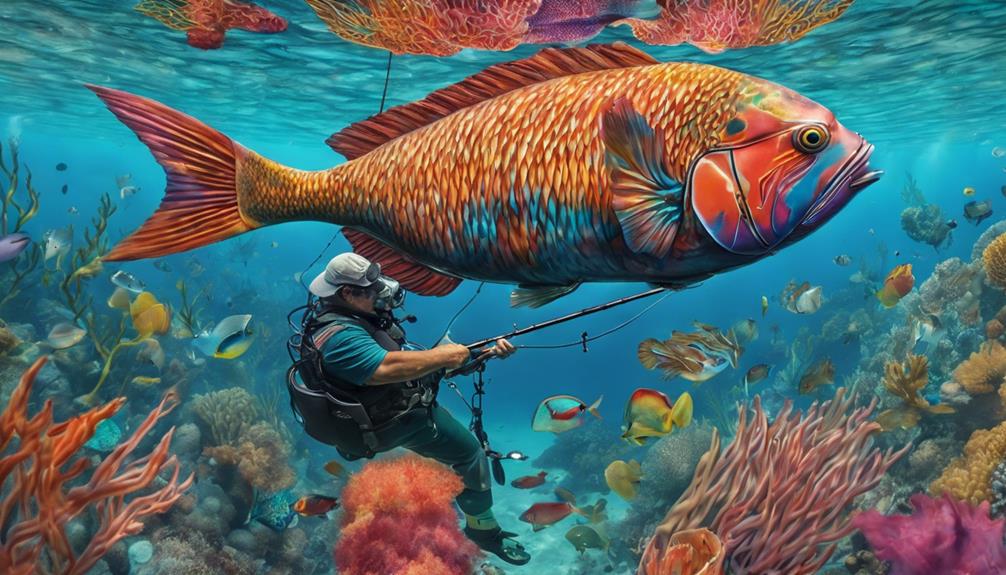Seeking success in saltwater fishing involves mastering species-specific techniques. From Snook to Tarpon, each fish demands precise strategies for a fruitful catch.
As you navigate the waters, understanding the nuances of Redfish Fishing Strategies or the art of Tarpon Fishing Tips becomes essential.
The secrets of Flounder Catching Methods and Mahi-Mahi Angling Tricks await your discovery.
Stay tuned to uncover the depth of Tuna Fishing Approaches and the subtleties of Grouper Hooking Tactics.
The realm of Shark Baiting Techniques promises a world of challenges and rewards.
Snook Fishing Techniques
When targeting snook, mastering the art of casting accurately can significantly increase your chances of a successful catch. Snook are known for their elusive nature, especially when it comes to snook lure selection. Opt for lures that mimic the baitfish commonly found in snook habitats. When aiming to catch snook at night, consider using lures that create vibrations or have rattling noises to attract them in low-light conditions.
Snook bait presentation is crucial for enticing these finicky fish, particularly when targeting snook in mangroves. When using live bait, ensure it appears as natural as possible by hooking it properly to maintain its lifelike movement. Additionally, adjusting the weight of your bait based on the water's depth can enhance its presentation and increase your chances of a successful hook-up.
Fishing for snook at night requires a different approach compared to daytime fishing. Since snook are more active during the night, consider using topwater lures to create commotion on the surface and draw them out of their hiding spots. Pay attention to the moon phases and tidal movements, as these factors can influence snook behavior during the night.
Redfish Fishing Strategies
To improve your success in catching redfish, focus on selecting the right bait for the specific conditions of the area you're fishing in. Redfish are known to be opportunistic feeders, so choosing the appropriate bait is crucial. Opt for live bait such as mullet, shrimp, or crabs for best results. Additionally, consider the size of the bait to match the size of the redfish in the area.
Casting accuracy plays a vital role in redfish fishing. These fish are often found near structures like mangroves or oyster beds, so precise casts close to these areas can increase your chances of a bite. Practice your casting technique to ensure your bait lands where the redfish are likely to be.
When it comes to tide timing, redfish are more active during moving tides. Focus your fishing efforts around the incoming or outgoing tides to maximize your catch. Keep an eye on the tide charts for the area you're fishing in to plan your trip accordingly.
A stealthy approach is essential when targeting redfish. These fish have a keen sense of smell and can be easily spooked. Avoid making loud noises or sudden movements that could scare them away. Move quietly along the shorelines or flats to increase your chances of hooking a redfish.
Tarpon Fishing Tips
For successful tarpon fishing, mastering the art of hooking these powerful silver kings requires adaptability and strategic bait selection. Understanding tarpon migration patterns is crucial for increasing your chances of a successful catch. Tarpon are known to migrate seasonally, moving between different habitats such as coastal waters, estuaries, and even freshwater rivers. During their migration, tarpon often follow warmer water temperatures, so targeting areas with suitable temperatures can enhance your fishing results.
When it comes to tarpon bait preferences, these fish are notorious for being opportunistic feeders. Live bait such as mullet, crabs, and pinfish are popular choices among anglers targeting tarpon. However, artificial lures like soft plastic swimbaits, topwater plugs, and spoons can also be effective in enticing these silver giants. Experimenting with different baits and adjusting your presentation to match the tarpon's feeding behavior can significantly improve your success rate.
To maximize your chances of hooking a tarpon, consider the time of day and tidal movements. Tarpon are known to be more active during dawn and dusk when they're feeding, so planning your fishing trips around these times can be advantageous. Additionally, paying attention to tidal changes and fishing during incoming or outgoing tides can increase your opportunities for a successful tarpon catch. Remember, patience and persistence are key when targeting these prized gamefish.
Flounder Catching Methods
Master the art of using live bait effectively to increase your success in catching flounder. When it comes to flounder baiting secrets, live bait is a game-changer. Opt for live minnows, mullet, or shrimp to attract these bottom-dwellers effectively. The key is to present the bait naturally, allowing it to move with the water's current to entice the flounder.
Incorporating proper flounder reel techniques is crucial for a successful catch. Utilize a sensitive rod and reel combo to feel the subtle bites of flounder. When you sense a bite, give the flounder a moment to fully take the bait before setting the hook. This patience is essential for hooking these sometimes cautious feeders.
Experiment with different retrieval speeds to find what works best. Flounder are known to strike when the bait is moving slowly along the bottom, mimicking their natural prey. Remember to keep the line taut to ensure a good hook set when the flounder bites.
Mahi-Mahi Angling Tricks
When targeting Mahi-Mahi, adjust your angling techniques to capitalize on their swift movements and vibrant colors in the water. To enhance your chances of a successful catch, consider Mahi-Mahi trolling tactics and bait selection. These fish are known for their acrobatic displays, so be prepared for an exhilarating fight once you hook one.
Offshore fishing hotspots are where you'll likely find Mahi-Mahi. Look for floating debris, weed lines, or temperature breaks in the water, as these are prime locations for these fast-swimming fish. When trolling for Mahi-Mahi, use colorful lures and baits to mimic their natural prey and attract their attention. Squid, ballyhoo, and artificial lures like plastic squids or small fish-shaped lures are popular choices.
In terms of gear recommendations, equip yourself with medium to heavy rods that have a bit of flex to handle the Mahi-Mahi's spirited runs and jumps. Pair these rods with durable reels that have a smooth drag system to prevent line breakage during the Mahi-Mahi's sudden bursts of speed. Additionally, consider using fluorocarbon leader material to increase your chances of landing these dazzling fish. By incorporating these Mahi-Mahi angling tricks into your fishing arsenal, you'll be well-prepared to reel in these prized catches.
Tuna Fishing Approaches
Optimize your chances of a successful tuna catch by fine-tuning your fishing techniques to match the swift and powerful nature of these prized fish. When it comes to tuna fishing, mastering specific approaches is key to reeling in these high-energy creatures. Here are some essential techniques to enhance your tuna fishing game:
- Tuna Trolling Techniques: Trolling involves dragging lures or baits behind a moving boat. To attract tuna, use brightly colored lures that mimic the fish they prey on. Vary your trolling speed to find the optimal pace for enticing tuna to strike.
- Tuna Jigging Methods: Jigging is a technique that involves vertically jerking a lure up and down in the water to mimic the movement of prey. When jigging for tuna, opt for heavy jigs to reach the depths where tuna often reside. Experiment with different jigging motions to trigger a reaction bite from these fast swimmers.
- Stay Alert: Tuna are known for their speed and can quickly change direction. Keep a keen eye on your line for any sudden movements that could signal a tuna strike.
- Use Quality Gear: Invest in high-quality reels, rods, lines, and terminal tackle to handle the strength and agility of tuna.
- Adapt to Conditions: Be flexible with your techniques based on weather, water conditions, and the behavior of the tuna on that particular day.
Grouper Hooking Tactics

Enhance your chances of a successful grouper catch by refining your hooking tactics to suit the behavior and feeding habits of these bottom-dwelling predators. Grouper are known as bottom dwellers, often found near reefs, wrecks, and other structures on the ocean floor. To effectively hook grouper, live baiting is a proven technique that entices these predators to strike.
When targeting grouper, it's crucial to present your bait where they're most likely to be. Since grouper are bottom feeders, you want your bait to reach the seafloor where these fish are actively hunting. Using live bait such as small fish or crustaceans can mimic the natural prey of grouper and increase your chances of a successful hook-up.
To maximize your grouper hooking tactics, consider using a fishfinder rig that allows your bait to drift naturally with the current while staying close to the bottom. Grouper have a keen sense of smell and are more likely to investigate and strike a live bait presented in a natural and enticing manner. By adapting your hooking tactics to match the behavior and feeding patterns of these bottom-dwelling predators, you can significantly improve your chances of landing a prized grouper on your next saltwater fishing adventure.
Shark Baiting Techniques
To increase your success in shark fishing, mastering effective baiting techniques is essential. When it comes to baiting sharks, using the right methods can significantly increase your chances of a successful catch. Here are some key points to consider:
- Quality of Chum: The effectiveness of your chumming technique plays a crucial role in attracting sharks to your fishing spot. Experiment with different types of chum to see what works best in your specific fishing location.
- Timing Matters: Sharks are known to be more active during certain times of the day. Understanding the feeding patterns of the sharks in your area can help you determine the best time to bait them.
- Bait Placement: Where you place your bait can make a big difference in attracting sharks. Consider factors such as water depth and current when deciding where to position your bait.
- Shark Behavior: Conducting research on shark behavior can provide valuable insights into the best baiting techniques. Understanding how sharks respond to different stimuli can help you fine-tune your approach.
- Contribution to Research: Engaging in shark tagging research while baiting can contribute to scientific knowledge and conservation efforts. Participating in tagging programs can help monitor shark populations and their movements.
Frequently Asked Questions
What Are the Best Types of Bait to Use for Saltwater Fishing in General?
When saltwater fishing in general, you'll find that live bait like shrimp or squid can be effective for a variety of species. Artificial lures such as spoons or jigs can also attract bites.
Trolling with lures or using live bait for bottom fishing are popular methods. Experiment with different bait types and techniques to see what works best for you in different saltwater fishing scenarios.
How Can I Properly Maintain My Fishing Equipment to Ensure Longevity?
To maintain your fishing equipment for longevity, keep it clean and dry after each use. Store rods and reels in a cool, dry place to prevent rust and corrosion.
Check for any signs of wear or damage regularly, and make repairs as needed. Properly lubricate moving parts and store gear in protective cases when not in use.
These simple steps will ensure your equipment stays durable and ready for your next fishing adventure.
Are There Any Specific Regulations or Restrictions to Be Aware of When Saltwater Fishing?
When saltwater fishing, it's crucial to be aware of specific regulations. Fishing licenses are required, and there are catch limits to follow. Conservation efforts play a big role in maintaining marine life populations.
Make sure to check the regulations in your area before heading out to ensure you're in compliance with the rules. Keeping up to date with any changes can help you enjoy fishing while also contributing to the preservation of the environment.
What Are Some Common Mistakes That Beginners Make When Saltwater Fishing?
When you first hit the saltwater for fishing, common mistakes can trip you up. Not paying attention to proper techniques like casting accurately or using the right bait can lead to frustration.
Ignoring the tides and currents might leave you empty-handed. Remember, take the time to learn the basics and ask experienced anglers for advice.
Avoid these pitfalls, and you'll improve your chances of reeling in a big catch.
How Can I Improve My Casting Accuracy and Distance When Fishing in Saltwater?
To boost your casting accuracy and distance in saltwater fishing, focus on tackle selection and line management. Consider gear that reduces wind resistance for better control.
Practice precision techniques like proper wrist action and timing. Experiment with different weights and lengths of lures or bait to find what works best for you.
With consistent practice and attention to detail, you'll see improvements in your casting skills over time.
Conclusion
Now that you've learned species-specific techniques for saltwater fishing, you're ready to hit the water with confidence.
Remember to adjust your approach based on the type of fish you're targeting, and don't be afraid to try different techniques until you find what works best for you.
With practice and patience, you'll be reeling in your desired catch in no time.
Happy fishing!



